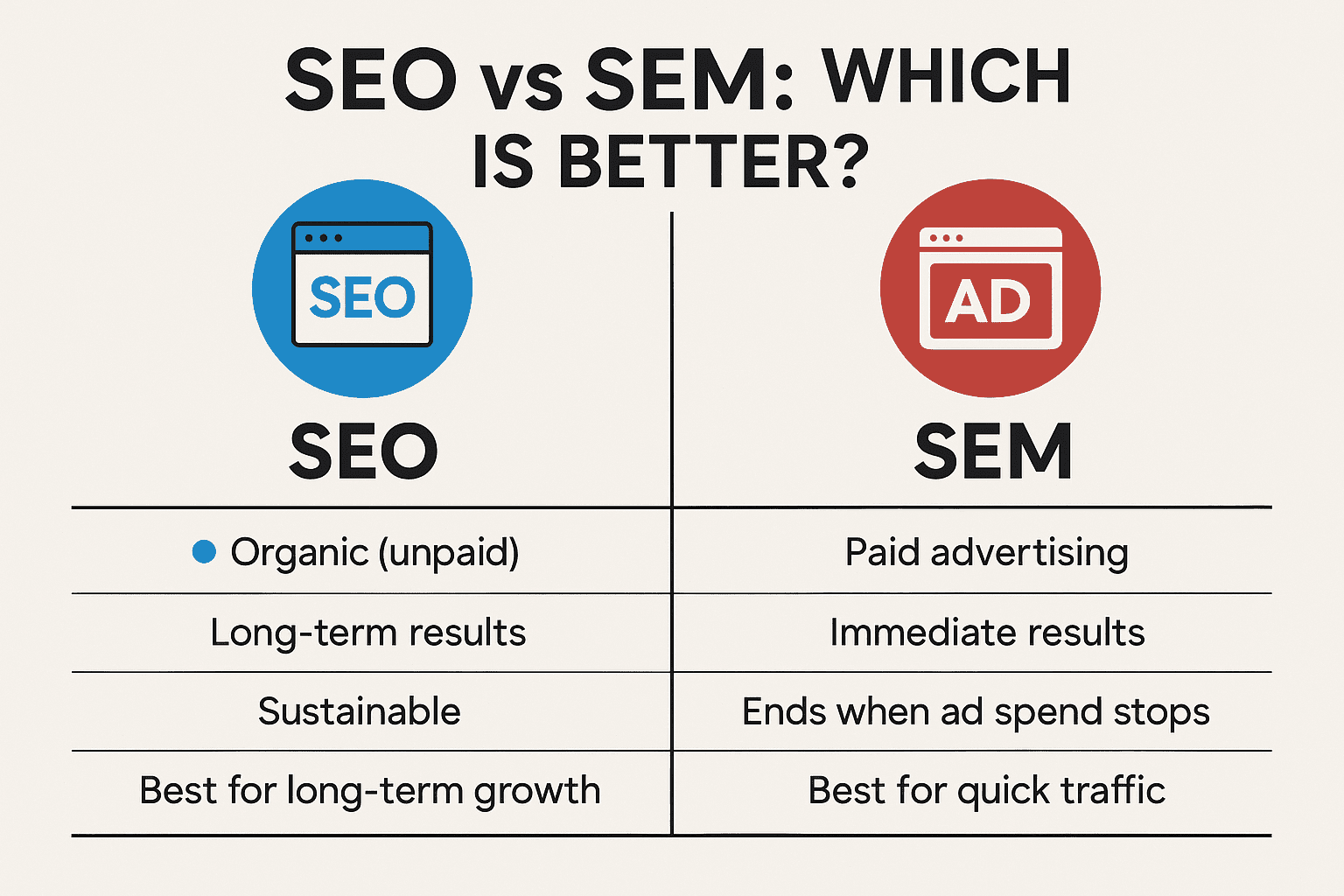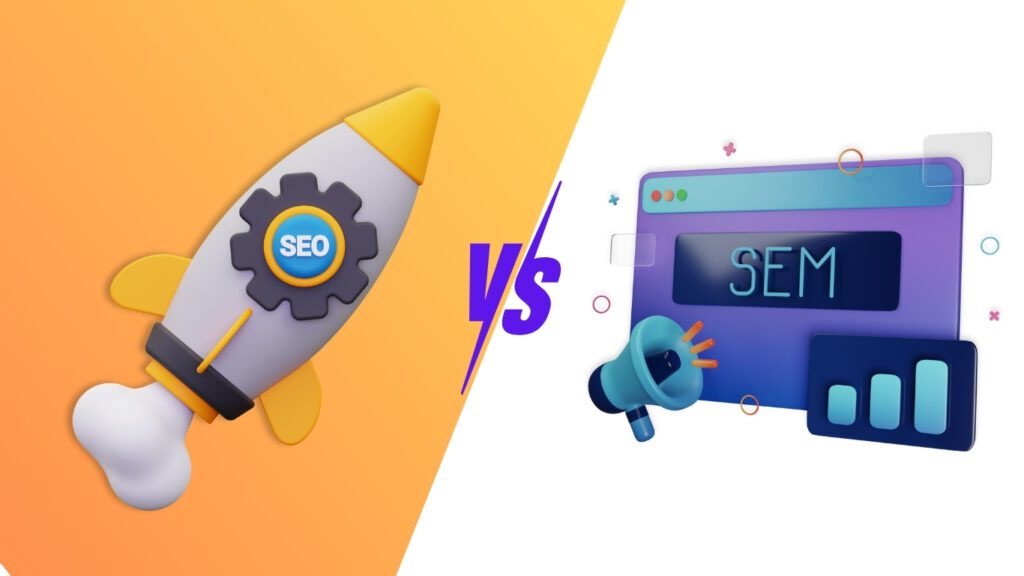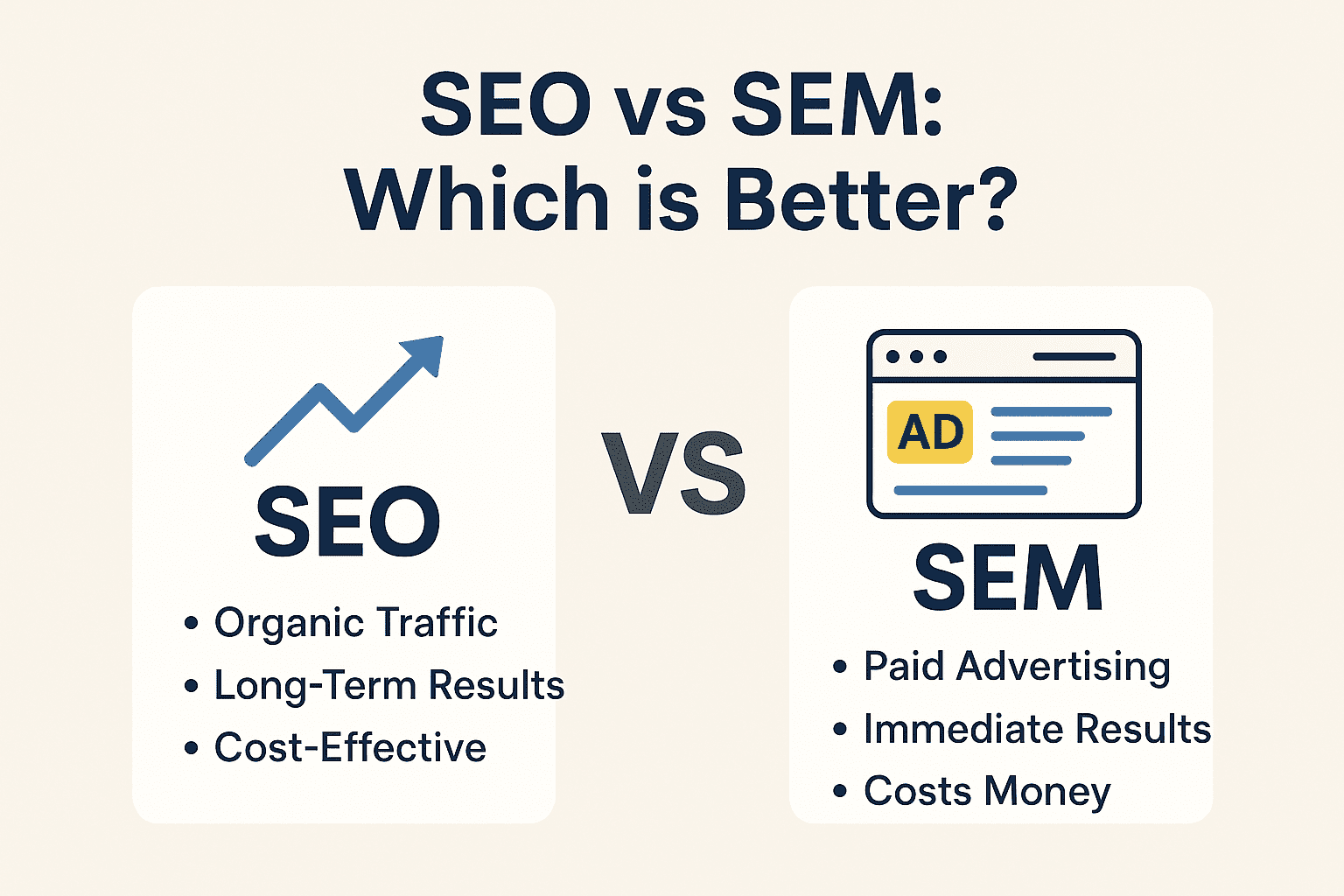
Imagine this is you’ve built an amazing website. It looks great, your services or products are solid, and you’re ready to welcome a flood of visitors. But… crickets. Nobody’s finding you.

That’s where SEO vs SEM step in Both are tools to help you show up when someone searches online for what you offer. But they work very differently, and choosing the right one (or a mix of both) can make or break your visibility online.
First Things First: What’s SEO?
SEO (Search Engine Optimization) is like planting a tree. You carefully choose the right spot (your website structure), nurture it with great content (blogs, keywords, backlinks), and with time and care, it grows and attracts people, all organically, without paying for clicks.
SEO is the art of showing up on Google without paying for ads. It’s about:
- Writing helpful, keyword-optimized content
- Making sure your website loads fast and works well on mobile
- Building trust by getting backlinks from other sites
- Optimizing technical stuff like site structure, meta tags, etc.
It’s not magic. But when done right, SEO brings free, high-quality traffic that keeps coming, month after month.
Then, What’s SEM?
SEM (Search Engine Marketing) is more like renting a billboard. You pay Google (or Bing) to put your ad at the top of the search results instantly. When someone types in something like “best digital camera for beginners”, and you’re running SEM ads, boom, you’re right there in front of them.
Also called PPC (Pay-Per-Click), SEM is:
- Buying ads on platforms like Google Ads
- Choosing specific keywords to target
- Writing short, compelling ad copy
- Sending people to a custom landing page
- Paying only when someone clicks
It’s fast, effective, and measurable, but once you stop paying, your ad disappears.
🆚 SEO vs SEM: The Real Differences
Let’s make it simple, here’s how SEO vs SEM compares in real-world terms:

| Factor | SEO (Organic) | SEM (Paid Ads) |
| Speed | Slow burn (3–6 months or more) | Instant visibility |
| Cost | No cost per click, but time-intensive | You pay for every click |
| Trust | More trusted by users | Some users skip ads |
| Longevity | Long-lasting once ranked | Temporary (only works while paying) |
| Control & Testing | Limited control over ranking changes | Full control + A/B testing |
| Best For | Long-term growth | Promotions, product launches, urgency |
When Should You Use SEO?
Choose SEO if you’re:
- Thinking long-term and want sustainable traffic
- Working with a smaller budget but can invest time
- Wanting to build your brand’s credibility and trust
- Ready to create helpful content like blogs, guides, FAQs, etc.
Example: A local seo services in Delhi could use SEO to rank for “best SEO Serivces near me” and slowly build a loyal audience through blog content and reviews.
Pros of SEO:
- Free clicks forever (once ranked)
- Builds brand authority
- Works 24/7 without paying for traffic
- Higher click-through rates in the long run
Cons of SEO:
- Takes patience and consistency
- Algorithms can shift your rankings
Competitive keywords can be tough to rank for
When Should You Use SEM?
Go for SEM when:
- You need results fast (like next week)
- You’re launching something new or seasonal
- You want to test keywords before investing in SEO
- You’re targeting highly competitive keywords where ranking organically would take forever
Example: A fashion brand launching a Diwali collection can run Google Ads for “Diwali ethnic wear for women” and show up instantly when people are searching to shop.
Pros of SEM:
- Fast traffic and measurable results
- Complete control over keywords and budget
- Perfect for promotions or short-term campaigns
Cons of SEM:
- Can be expensive (especially in competitive niches)
- Traffic disappears the moment your ad budget runs out
- Lower trust, some people ignore or block ads
So… Which One’s Better?
This might sound like a cop-out, but here’s the honest truth:
It’s not about which is better, it’s about which is better for you right now.
If you’re playing the long game and want steady, reliable traffic over time, go with SEO.
If you need quick wins, leads next week, or want to test the waters, go with SEM. If your budget and bandwidth allow it, do both. Use SEM to bring in traffic while your SEO efforts are building in the background.
How SEO and SEM Can Work Together
The smartest marketers don’t pick sides. They integrate both strategies:
- Use SEM to test which keywords convert best, then build SEO content around those.
- Run retargeting ads to people who found you through SEO but didn’t convert.
- Drive traffic through SEM while you wait for your SEO rankings to kick in.
Together, SEO + SEM can create a powerful feedback loop, combining long-term growth with short-term action.
Final Thoughts on SEO vs SEM (From One Business Owner to Another)
Let’s be real, digital marketing can feel overwhelming. Algorithms, competition, ad budgets… it’s a lot.
But here’s the good news: You don’t have to do it all at once.
Whether you start with SEO, SEM, or both, what matters is that you start. Show up. Experiment. Track results. Learn what works. Adjust as you go.
Because at the end of the day, it’s not just about traffic or rankings.
It’s about building something real, a brand people can find, trust, and believe in.
And if you ever find yourself stuck between choosing SEO vs SEM, just remember this:
SEO is the engine that powers long-term growth.
SEM is the accelerator that gives you a boost.
Together? They’re unstoppable.
